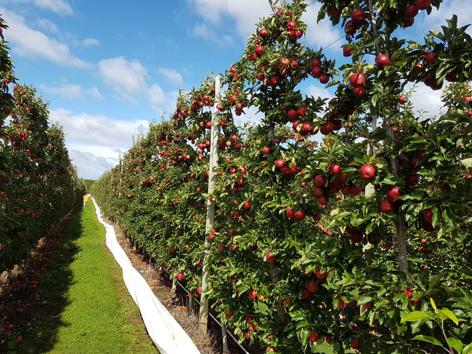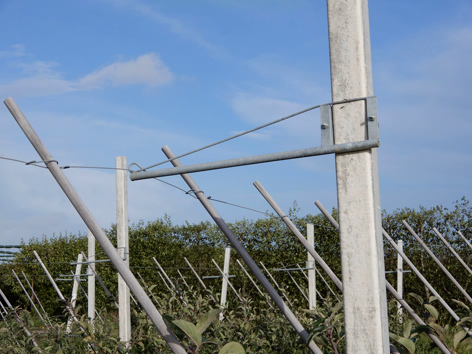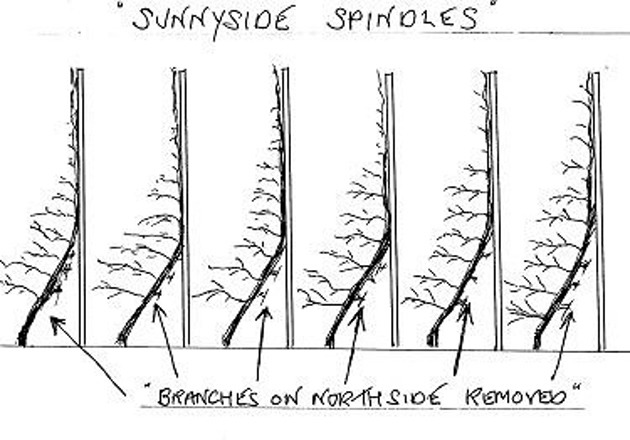

Today: Friday 18th October The English Apple Man met Vikram Singh Thakur (a friend) and Rob Saunders from Hutchinson's of Wisbech to view an experimental tree management system trials named HELIOS
After a relaxed lunch at The Haywain at Brambling we drove the few miles to Hoaden Court Farm where one of the two HELIOS trials is taking place. There we met Rob's colleague Ivan Velasco who is assisting in the HELIOS trials. The second trial site is in Herefordshire.
Below: Vikram - Ivan - Rob
Maximising light interception is the key driver for any orchard management system.
Helios - Thinking Outside the Box
The text below is a statement by Hutchinson's defining the objectives of HELIOS
"Hutchinsons are proud of the excellent specialist service they provide to fruit growers, but they are not resting on their laurels and continue to think ahead and outside the normal realms of agronomic advice by initiating and investing in a ground breaking 10 year project in top fruit, called HELIOS (Hutchinsons Enhanced Light Interception Orchard System).
The project is based on the simple premise that the ultimate yield of apples is relative to how much light the tree can get, explains Rob Saunders, one of their specialist agronomists.
He explains that Hutchinsons are setting up from scratch two orchards of Gala, one in the West Midlands and one in Kent, where they will be trying to break through the theoretical yield barrier.
In John Nix Farm Management Pocketbook 2017, the yields for dessert apples are reported to be between 25 and 50 tonnes per hectare and for culinary apples between 30 and 55t/ha.
Growers have managed to exceed these figures but often at the expense of quality and consistency. "We have always thought there is a theoretical ceiling of 60 t/ha yield," says Rob. "But can we break through that ceiling?
This is what we are aiming to do."
"We think it may be feasible to achieve consistently higher crops of quality fruit if the tree is able to capture more sunlight.
By redesigning the canopy and tree architecture, it should be possible to intercept more light which should mean higher yields.
The Helios project has been set up to see if this theory can be proven. We are planting trees from different root stocks, thinking of different support systems and redesigning the way the trees grow so that less light is wasted by getting to the orchard floor. We have thought about more of a canopy in a simple horizontal plane with little depth ie flatter canopies more open to the light," says Rob.
The idea of Helios is to see how yields can be increased and how an orchard can be established more cost-effectively. The project is scheduled for ten years and growers will be invited to one of the sites to see for themselves how the project is progressing during that time.
Hutchinsons are becoming renowned for developing ground breaking systems for growers. In arable crops and also now in fruit they have the Omnia Precision system which is a unique unrivalled precision farming system using Multi-Dimensional Data Analysis for whole field crop and nutritional planning system.
"We are also developing the pioneering Fruit Vision system which counts and measures crop yield as it moves through the orchard. This system was sent to the Southern hemisphere this winter for further development and is now back in the UK for final configuration and testing," reports Rob. He also points out that FruitVision imaging process is really the first step to automated picking.
"When finally developed to the standards we are looking for FruitVision could revolutionise fruit growing. With labour costs doubling every ten years, automated picking will be a huge step forward to more profitable fruit growing. Hutchinsons is looking and investing into the fundamentals of fruit growing, so that they can offer advanced developments to their grower customers."
HELIOS trial site - Hoaden Court Farm
The English Apple Man features a few of the systems in the HELIOS trials!
As we toured the trials site, Rob Saunders and Ivan Velasco explained the objectives and fine tuning of circa 20 different tree management trial elements on different rootstocks and tree spacing in the row, with all using Gala Galaxy. All alleyways are a standard 3.5 metres, primarily for standardising the trial orchard with Hoaden Court for spraying purposes. Any new commercial orchards would utilise row spacing commensurate with each system to maximise yield and quality per system.
Below: left; Galaxy Gala on M26 rootstock @ 1.2m apart and right; a Four stem tree system 1.4m spacing
While some tree management systems at HELIOS are already in operation in orchards in the UK and EU countries, some are inspired by trails in other countries and particularly the work of Stuart Tustain in New Zealand.
The Guyot system in the HELIOS trial is inspired by the Guyot Grape training and Stuart Tustain's Multistem system for apples. The objective to grow several 'super spindle' cropping units at close intervals increasing the cropping units per hectare and (in theory) increasing the yield and quality.
Below: left; Guyot trained Gala Galaxy tree and right; picture of the bend formed to train the tree as a vertical planar canopy.
Below: left; 2 dimensional format in New Zealand and right; Multistem format in New Zealand

Below: HELIOS trial trees in a sloping V format - trees alternate in direction to form a V
A very interesting trial features the PhotoVoltaic system: Photovoltaic panels convert the sunlight directly into electricity: This HELIOS trial follows the principle of capturing light to make electricity; instead by setting the trees into the same angle, the trees maximise the interception of sunlight enhancing yield, quality and colour. The rows are set East to West with the head facing North. This maximises the capture of light.
Below: left; Gala Galaxy PhotoVoltaic system and right; 'the support system'

Below: one of the Gala Galaxy PhotoVoltaic rows in the HELIOS trial. Planting distamces of 0.78m and 1.4m spacing are being trialled. The Canopy is sloped at 50 degree to the North.
The visit to HELIOS gave a very interesting insight into the potential growing systems which may (or may not) become popular in the future. The PhotoVoltaic trial is all the more interesting to the EAM as it reminds me of John Breach's Sunny Side System planted at Hadlow College in 2013.
John Breach summarises the Sunny Side system.
 "The Sunny-Side system was conceived as an experiment to see if the colour grade-out of bi-coloured apples (Gala, Braeburn etc.) could be improved by optimising the available sunlight and by reducing the quantity of fruits growing 'in the shade' The system is based on: planting each tree approximately 30cm to the south of the tree stake (or the line of wire-work, if used instead of individual stakes - on the East - West orientated rows).
"The Sunny-Side system was conceived as an experiment to see if the colour grade-out of bi-coloured apples (Gala, Braeburn etc.) could be improved by optimising the available sunlight and by reducing the quantity of fruits growing 'in the shade' The system is based on: planting each tree approximately 30cm to the south of the tree stake (or the line of wire-work, if used instead of individual stakes - on the East - West orientated rows).
By tilting the top of the tree to the North; fixing the tree to the top of the stake; then removing all the 'North' facing branches. In subsequent years, pruning involves removing any new North facing branches, together with any that are too low, or crossing. As the canopy thickens and becomes more dense, pruning to ensure fruit bud quality is maintained will require selective removal of stronger wood/branches"
I am note sure if John Breach was the inspiration for the PhotoVoltaic tree system, but he was certainly on the right track back in 2013. Click on Sunny Side Tree Format 2013
Late edition! Four picture sent to me by Ivan Velasco of fruit on the trees at harvest 2019.
Below: Gala Galaxy on M9 at 0.86m apart and right; Leaning V spindle Gala Galaxy on M9 at 0.39m apart
Below: Gala Galaxy on M26 at 1.26m apart and right; PhotoVoltaic Gala Galaxy on M9 at 0.78m apart
There is so much more information worthy of discussion/investigation in the HELIOS trials and The English Apple Man will follow with great interest the ongoing results in future Journals!
Finally: On Thursday I visited my friends Matthew and Carol Wilson who have been growing apples and pears organically in East Sussex for circa 20 years; we were tasting a variety of mutual interest, over a cup of tea and much 'nattering' - in the farm yard I took two pictures which fits perfectly their love of natural growing.
Below: left; Nasturtiums are 'in the mix' and right; Dessert grapes, Figs and more Nasturtiums
That is all for this week - next week is The 86th National Fruit Show and The EAM will report some of the areas of interest in next week's Journal
Take care
The English Apple Man